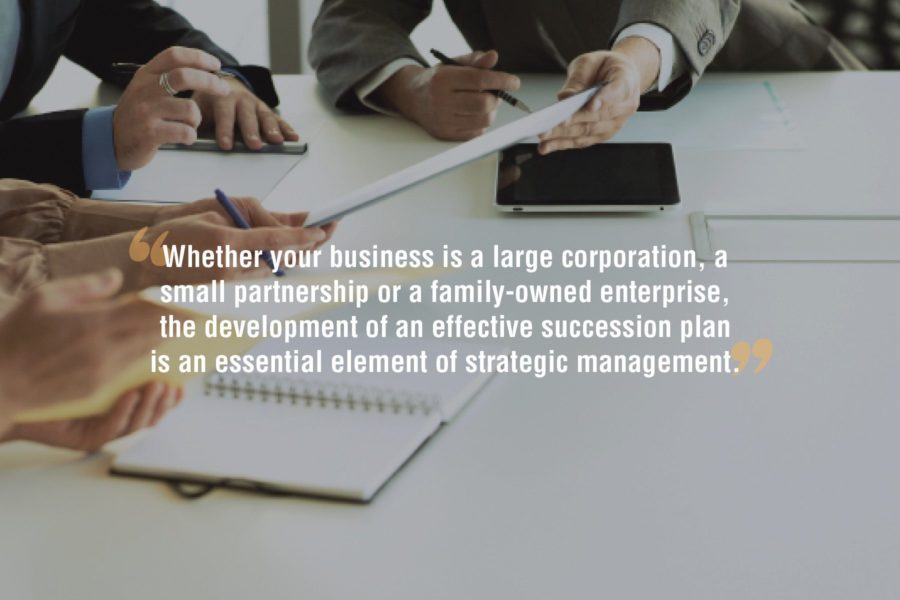There are many unknowns in business, but one event is guaranteed and universal: every business will have a succession, whether the incumbent retires, resigns or is removed by fortune or fate.
Whether your business is a large corporation, a small partnership or a family-owned enterprise, the development of an effective succession plan is an essential element of strategic management. A corporate CEO will share this task with a board of directors, and the founder of a family business will have personal ties to consider. However, in all cases, succession planning will benefit from the same patient steps toward the desired outcomes for the organization and its stakeholders.
Here is a 20-step checklist to help develop your unique succession plan.
1. Establish the Importance of Succession Planning
The casino billionaire Sheldon Adelson famously dismissed the need for succession planning, telling an interviewer, “I have no intention to retire.” When Adelson died in January 2021, he left Las Vegas Sands, a $40 billion global enterprise, without a plan.
For a young CEO, departure can be unexpected. Travis Kalanick was forced out at Uber, as were Steve Wynn of Wynn Resorts, Andrew Mason of Groupon and Palmer Luckey of Oculus. Although succession planning may seem like a distant concern today, it is essential to provide for the stability of your business and the security of its stakeholders by planning for an orderly change of leadership.
2. Identify Stakeholder Objectives
In a corporate entity, the principal goal of succession planning is continuity, sustaining the business and keeping the mission and strategy on course. In addition, shareholders and financial analysts want to see successors with expertise in new businesses and technologies that can power new growth.
The primary goal of succession planning may be to cash out, to transfer ownership to the next generation or to step aside from active management into a role as counselor or head of research. Succession planning may also provide for the incumbent’s insurance and retirement package, the roles of successors and strategic transfers of intellectual property.
3. Define Family Objectives
In a family-run business, succession planning objectives are complicated by rights of inheritance. Some heirs have the interest and aptitude for business. Others may not. Warren Buffett compared the family succession planning process to “choosing the 2020 Olympic team by picking the firstborn of the 2000 Olympic medalists.”
Founders must determine whether the business will stay in the family or be sold when they retire. The founder’s estate must also be settled. Future roles must be envisioned for family members inside or outside of the business. The special challenge of family succession planning is how to achieve outcomes that are both practical business decisions and loving bequests between parent and child.
4. Include Technical Succession Planning Advisors
A corporate CEO has the advantage of a board that can take up a succession strategy. Because the succession planning process has consequences in taxation and securities law, working committees should draft the company’s CFO and corporate counsel. Early input is also required from insurance providers and lenders. To test its conclusions, the company may retain a consultant who specializes in succession planning.
5. Identify Potential Issues
The planning group must anticipate the ways in which the most thorough succession planning can be thwarted. If an incumbent brings a special personal value to his or her role, such as reputation or rare technical skill, effective succession planning may require key person insurance.
What would happen if the company founder had an accident and was alive, but disabled? What if the founder’s successor is lost in the same accident? Do succession buy-sell agreements include language for conflict resolution between partners, surviving spouses and heirs?
6. Identify Which Roles Require Succession Planning
In a corporate entity, consider plans for all of the C-suite leaders, as well as key positions at the director level. In a partnership, succession plans are required for all partners owning a share of the business. In a family company, succession planning is required for all incumbents who now hold or will acquire (or inherit) part interest.
7. Develop Profiles for Leadership Roles
What are each incumbent’s plans for retirement? Does the age or health of the incumbent raise any possibility that he or she could be forced to retire sooner? Should the company purchase key person insurance for this incumbent? What is the financial risk to the company if this incumbent suddenly died or became disabled? Is this incumbent party to a prenuptial or matrimonial agreement?
8. Develop Timelines with Planning Options
Each succession planning timeline needs an anticipated date of retirement, with what-if options to accommodate the potential for resignation, termination or some other unplanned departure.
In a partnership or closed corporation, plan agreements will specify how a former partner’s interest is to be financed and purchased. In both corporate and private businesses, each incumbent’s timeline should be mirrored by the career path of potential successors.
9. Document the Plan in Overview
When the goals, strategy and timing of the succession plan are established, outline the plan in overview for confidential discussion with operational management, human resources and family members. The succession planning process can become a source of rumors and misinformation unless the purpose and objectives of the plan are clearly established.
10. Solicit Feedback from Key Employees and Family
The succession plan should remain confidential until it is ready for all stakeholders. At the next level of input, senior management can invite key employees in leadership roles to comment on the objectives and voice any concerns. These team leaders also offer high potential for development as successors, or at minimum, their knowledge of key contributors will enable nomination of other candidates.
When a family succession plan is ready for discussion inside and outside the company, the business owner and principal advisors should be prepared to justify all reasoning with regard to roles inside the company, ongoing compensation, buy-sell agreements or other plans for transfer of ownership.
11. Anticipate and Resolve Conflict
The succession planning process requires management to evaluate potential successors, compare them with colleagues, make known their unique standing, allocate resources to their career development and communicate these decisions throughout the organization.
Inevitably, some alternate candidates in key positions will regard these choices as errors in judgment. With successors who are related, it can be difficult to avoid the impression that one sibling is unjustly favored with a great job or a fast track to management. Be ready for objections, and be generous in sharing the logic underlying each succession planning decision.
12. Communicate the Plan to all Stakeholders
Publish an overview for employees, key customers, vendors and financial partners to let them know that the company is actively planning succession. The details of the plan can remain confidential, but general information that the company has an orderly succession plan in place will demonstrate foresight and will build confidence in the current leadership and their successors.
13. Integrate the Org Chart with Succession Planning
A company’s overall organizational plan should include the leadership development of potential successors. Candidates for succession should be told privately that they are being considered for key roles. Candidates should understand that there are no guarantees, but that the company recognizes their high potential and the opportunity is there if they can ascend to it.
Are they committed to staying with the company? Are they willing to receive accelerated training, rotate through other departments and spend extra time with company mentors?
14. Develop Multiple Candidates with High Potential
Virginia Rometty joined IBM as a systems engineer, rising through the ranks to SVP and Group Leader for Sales, Marketing & Strategy. Ms. Rometty was one of four potential successors to the CEO. When the leading candidate was disqualified for misconduct, this attention to succession, with a plan in place for all leadership positions, gave IBM the bench strength to move forward without interruption.
15. Set High Standards
Successor candidates, especially in a family-owned business, must have qualifications equal to key employees at the same level. If another employee offers more talent, knowledge or personal drive, perhaps that employee should be the successor.
Candidates need to know that character counts in leadership roles. Regardless of the company’s plans for their career development, successors must be held to the organization’s highest standards of performance, discipline and accountability.
16. Map the Career Path for Successors
When planning succession, create job descriptions listing the skills and experience required to assume the successor’s future role. Beyond their present responsibilities, successors should have cross-functional assignments, mentoring, contact with customers and exposure to financial, legal, insurance and tax advisors.
Leadership requires strong communication skills. Successors must be able to express themselves clearly and persuasively in writing or when speaking to groups. Address any gaps in candidate skills or experience with long-term training.
17. Review Alternate Scenarios
When the succession plan has been considered throughout the company (or family), review feedback and revisit the main elements of the plan to determine where potential outcomes or contingencies may have been overlooked. Ensure that provisions for conflict resolution are included in corporate or partnership agreements.
18. Develop Transfer Strategies
Should the transfer of equity to related successors be a buy-sell agreement? How will the purchase be financed? How can a founder’s survivors guarantee the loan payments? What are the tax implications of a purchase versus a bequest? What insurances are required for health, life or disability?
19. Settle the Departing Owner’s Equity
What is the plan for distributing shares of ownership or profit to heirs? If the business will not be sold, how will successors settle the founder’s estate? Does a buy-sell agreement specify how the value of the business will be determined?
What are the tax implications of inheritance? How will the estate provide for children who are not active in the business? In a partnership, should a successor or key employee be named in the plan as the designated buyer of a departing partner’s shares?
20. Annual Review
A well-developed plan should only require an annual checkup. Are the goals of the plan still valid upon review? Is progress toward all plan objectives satisfactory? Are the successor candidates on track? Have there been any changes among incumbents, successors or their families? Are insurances suitable for the succession triggers of retirement, death or disability?
For more information on the financial and personal aspects of succession planning, talk with a Higginbotham company advisor. Contact us today.





